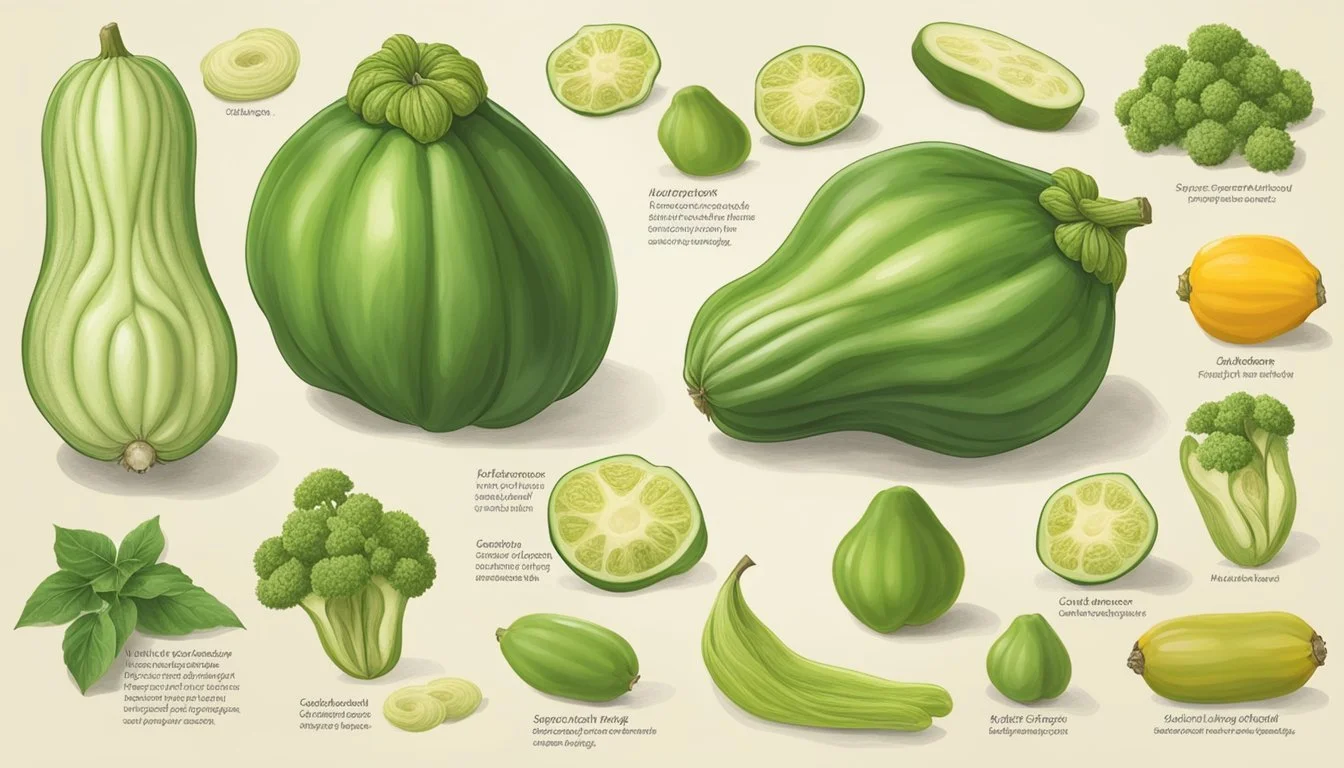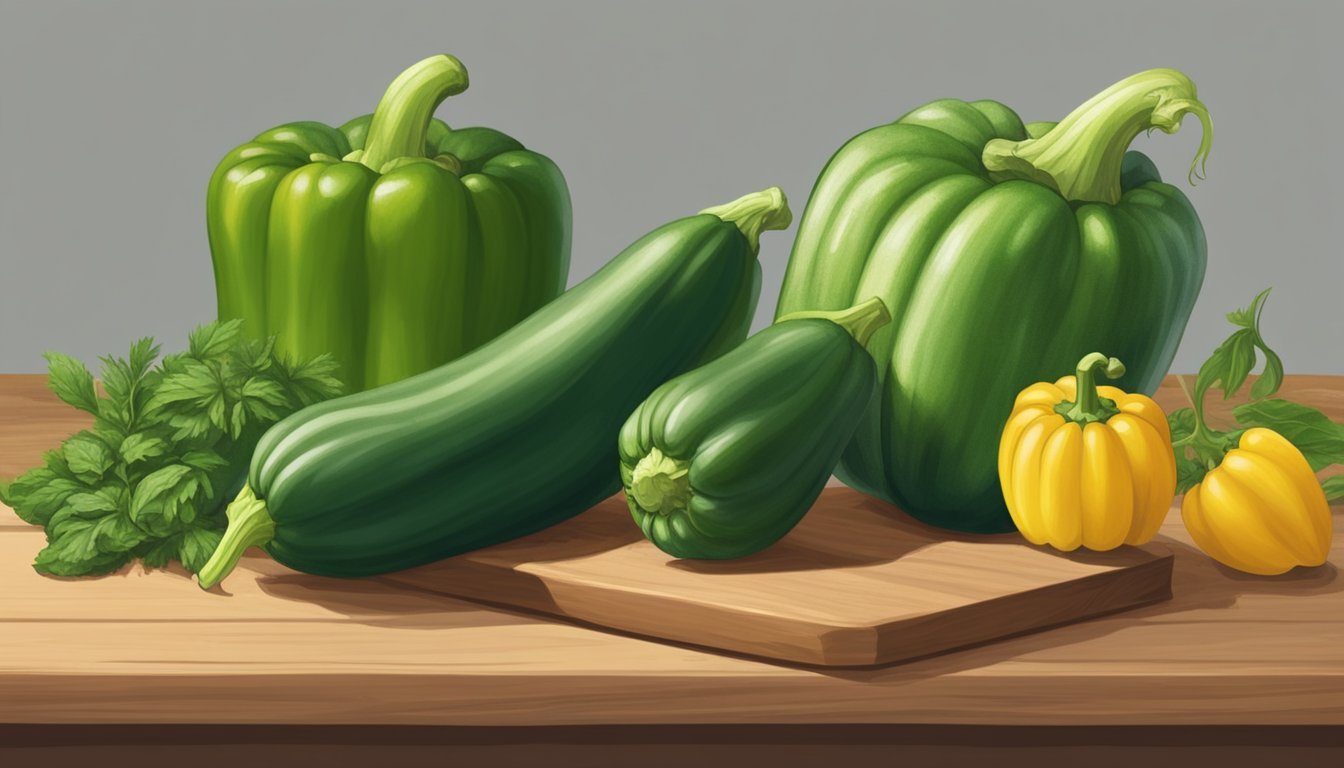Chayote Squash Substitutes
Best Alternatives for Cooking
Chayote squash, also known as vegetable pear or mirliton, is a versatile ingredient with a mild, slightly sweet flavor. Its unique texture and taste make it a popular choice in many culinary applications. For those times when chayote isn't available, there are several effective substitutes that can seamlessly stand in.
When seeking to replicate the crisp texture of chayote in raw dishes such as salads, cucumber works remarkably well. Cucuzza, another type of squash, can effectively replace chayote in cooked recipes, delivering a similar nutty flavor. Yellow crookneck squash is also an excellent substitute due to its delicate taste and compatibility with a range of dishes.
These alternative options ensure that a lack of chayote won't hinder your cooking endeavors. Each substitute offers its unique qualities, but all retain the blend of texture and flavor that chayote brings to the table, enriching your recipes with a comparable nutrition profile and culinary versatility.
Understanding Chayote Squash
Chayote squash, a member of the gourd family, is known for its pear-shaped form and green color. It holds various culinary uses due to its mild flavor and numerous health benefits, including a rich nutritional profile packed with vitamins, minerals, and antioxidants.
Characteristics of Chayote
Chayote squash is typically pear-shaped with a distinct green exterior. The skin can range from smooth to slightly wrinkled, and the flesh is pale green to white. Its texture is crisp when raw and becomes tender when cooked.
The flavor of chayote is mild and somewhat sweet, making it versatile for numerous dishes. Often, it is compared to a mix of cucumber and zucchini. It can be eaten raw, pickled, or cooked in various recipes. Its firm texture provides a satisfying crunch in fresh salads.
Nutritional Profile
Chayote squash is a nutritional powerhouse. It's low in calories yet rich in essential nutrients, making it a healthy addition to any diet. Key nutrients include:
Nutrient Amount per 100g % Daily Value Vitamin C 7.7 mg 13% Vitamin B6 0.12 mg 6% Folate 93 µg 23% Potassium 125 mg 3% Fiber 1.7 g 7%
This squash is also high in antioxidants and fiber, which support digestive health and reduce oxidative stress. The presence of potassium contributes to heart health, regulating blood pressure levels.
Common Culinary Applications
Chayote's mild flavor and firm texture make it adaptable in the kitchen. It is used in a variety of dishes, such as:
Salads: Shredded or thinly sliced, chayote adds crunch and freshness.
Stir-Fries: It pairs well with other vegetables and proteins.
Soups and Stews: Its texture holds up well when simmered.
Pickled: Preserving chayote enhances its crispness and introduces tangy notes.
The versatility extends to both raw and cooked preparations, providing chefs and home cooks with many options. Whether grilled, boiled, baked, or sautéed, chayote adds a delightful component to numerous recipes.
Suitable Chayote Substitutes
Chayote squash, a versatile ingredient in many recipes, has several suitable alternatives. These substitutes share similar taste and texture profiles, making them ideal replacements in cooking.
Zucchini and Summer Squash
Zucchini is a popular substitute for chayote due to its mild flavor and firm texture. Both vegetables can be used interchangeably in a 1:1 ratio. Zucchini's slightly sweet taste complements a variety of dishes, from salads to stir-fries.
Summer squash, including varieties like yellow crookneck, offers another excellent alternative. It retains a firm texture when cooked and blends well with other ingredients. Both zucchini and summer squash can be sliced, diced, or spiralized, providing versatility in preparation.
Green Papaya
Green papaya is another suitable chayote substitute, particularly in Asian and Latin American cuisines. This unripe fruit boasts a crisp texture and a neutral flavor, similar to chayote. It works well in salads, soups, and slaws.
To prepare, peel the green papaya and remove the seeds. It can then be julienned or grated, adding a crunchy element to any dish. Its ability to absorb flavors makes it ideal for recipes that require a subtle base.
Cucumber and Kohlrabi
Cucumber serves as a great substitute in raw dishes. Its refreshing, mild flavor and crunchy texture make it perfect for salads and cold dishes. Though it contains more water, cucumber can occasionally be used in cooked recipes where moisture isn't an issue.
Kohlrabi is another versatile vegetable, offering a texture similar to both chayote and broccoli stems. Its mildly sweet and peppery flavor adds a unique twist to recipes. Kohlrabi can be eaten raw or cooked and holds its shape well, making it suitable for a wide range of culinary applications.
Each substitute brings its own unique qualities to a dish, allowing for flexibility and creativity in the kitchen. By understanding the distinct characteristics of these vegetables, one can seamlessly replace chayote in any recipe.
Preparation Techniques for Substitutes
Learning how to prepare substitutes for chayote squash can enhance your culinary creations, whether you're using them raw in salads or cooking them into delicious dishes. This guide covers techniques that ensure texture and flavor remain top-notch.
Raw Preparations
Substitutes such as zucchini and cucumber work well in salads. Zucchini should be peeled and thinly sliced to maintain crispness. Cucumber, with its naturally refreshing flavor, can be sliced into rounds or julienned for a crunchy texture.
Jicama can also serve as a raw substitute. It requires peeling and cutting into matchsticks. This preparation adds a light, juicy crunch to dishes. Similarly, bell peppers can be chopped or sliced to add color and a hint of sweetness to salads.
Cooked Applications
For cooked dishes, substitutes like zucchini, cucuzza, and bell peppers excel. Zucchini can be sautéed, grilled, roasted, or added to stir-fries and soups. When sautéing, cut zucchini into rounds or half-moons to ensure even cooking.
Cucuzza can be treated similarly but works especially well in stews. Cut into chunks and simmer until tender. This squash imitates chayote’s texture and flavor when cooked.
Bell peppers add vibrant color when grilled or roasted. Slice them into strips and place on a baking sheet for roasting, or grill them whole to add smokiness. Steamed, they become a nutritious side dish.
Jicama, once boiled, can be added to soups, absorbing flavors while maintaining a slightly crunchy texture.
Specific Substitutes in Diverse Dishes
When replacing chayote squash, the best alternatives vary according to the type of dish. Some substitutes provide a similar crisp texture, while others offer a comparable mild or buttery flavor. Understanding these specifics will help in making informed choices for a variety of culinary creations.
Alternatives for Salads and Slaws
Cucumber and green papaya are excellent substitutes for chayote in cold dishes like salads and slaws. Cucumbers share a similar crisp texture and refreshing, mild flavor. They can be used raw and maintain their crunchiness. Green papaya also provides a mildly sweet yet slightly bitter taste, which complements various salad ingredients. Both can be sliced or julienned and used in a 1:1 ratio.
Best Fits for Stews and Casseroles
For stews and casseroles, zucchini and bottle gourd are ideal replacements for chayote. Zucchini, with its versatile nature, can be roasted, grilled, or sautéed, adding both texture and a mild, buttery flavor to dishes. Bottle gourd, known for its mildly nutty and rich squash taste, works well in cooked dishes. This type of squash pairs perfectly with the savory aspects of stews and casseroles, ensuring the meals remain flavorful and hearty.
Choosing Substitutes for Steamed and Sautéed Dishes
Yellow crookneck squash and pattypan squash are great options when looking to replace chayote in steamed or sautéed recipes. Yellow crookneck squash offers a slightly sweet taste and tender texture, making it suitable for quick steaming or light sautéing. Pattypan squash, with its firm texture and mild flavor, can be lightly sautéed or steamed to add a delightful element to any dish. Both varieties are excellent at maintaining their texture and flavor during cooking, ensuring the dish doesn’t lose its appeal.
Regional Alternatives and Flavors
Substituting chayote squash varies based on the culinary traditions of different regions, incorporating local vegetables and specific cooking techniques.
Asian Cuisines
In Asian cuisines, fuzzy melon is a common substitute for chayote. This vegetable, also known as mo qua, shares similarities in texture and mild flavor. Fuzzy melon is particularly popular in Chinese and Southeast Asian dishes, where it is used in stir-fries, soups, and stews.
Patty pan squash can also replace chayote in various Asian recipes. Its slightly firmer texture and delicate taste make it versatile for sautéing or adding to broths.
Jicama, a crunchy root vegetable, often substitutes chayote in salads and fresh preparations. Its crisp texture pairs well with lime, chili, and cilantro, ingredients frequently used in Asian salads.
Caribbean and Latin American Influences
In Caribbean and Latin American cuisines, cucumber is a popular alternative. Its crisp, juicy texture and light flavor make it ideal for raw dishes like salads and salsas. The substitution ratio is 1:1, ensuring a balanced taste and texture.
Bell peppers and cabbage are also notable substitutes. Bell peppers, particularly in Caribbean dishes, add sweetness and color. These are often used in stews or sautéed preparations. Cabbage offers a crunchy texture in various cooked applications, such as soups or stir-fries.
Jicama again appears as a versatile replacement, especially in salads, combining well with traditional ingredients like lime and chili to create refreshing dishes. This root vegetable’s crispness and mild flavor align perfectly with Caribbean and Latin American tastes.
Food Pairings and Complementary Ingredients
Chayote squash pairs well with a variety of herbs, spices, proteins, fats, vegetables, and fruits, making it a versatile addition to many dishes. These combinations enhance its subtle flavor and crisp texture.
Herbs and Spices
Chayote squash benefits from the addition of fresh herbs like parsley, cilantro, and thyme. These herbs add bright, fresh notes to dishes.
Garlic and onion are also excellent choices, providing depth and aroma. A bit of chili powder or cumin can introduce a mild heat and earthy flavor. For a more aromatic profile, try ginger and lemongrass, especially in Asian-inspired recipes.
Combining these herbs and spices can result in a well-rounded flavor profile that complements the mildness of chayote.
Proteins and Fats
Chayote is versatile when it comes to proteins and fats. It pairs well with chicken and pork, as their flavors are not too overpowering.
Seafood, such as shrimp and white fish, work wonderfully too, adding a light, fresh component. For plant-based options, tofu and beans are excellent choices.
Cooking chayote with olive oil enhances its texture and flavor. Butter can also add a rich, creamy dimension. A bit of avocado or nuts like almonds or cashews can provide a satisfying crunch and additional healthy fats.
Vegetables and Fruits
Chayote complements a variety of vegetables and fruits. It pairs well with zucchini, crookneck squash, and yellow squash, offering a mix of textures and flavors.
Cucumbers and celery add a crisp, refreshing element. Celeriac can introduce a subtle, earthy taste that blends well with the mild flavor of chayote.
For fruits, try pairing chayote with apples, which add a sweet contrast. Mirlitons, also known as chayote squash, can be cooked together for a harmonious dish. Combining these ingredients can result in a vibrant, balanced plate that showcases both the flavor and texture of chayote.





